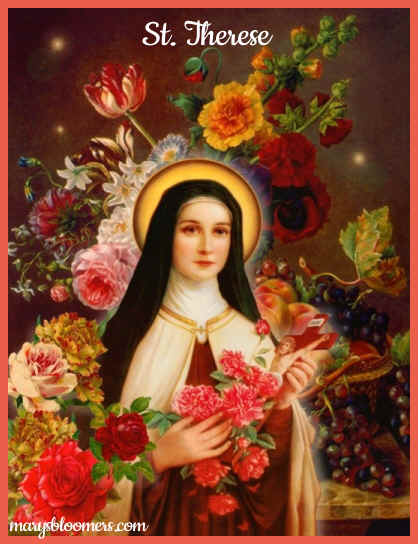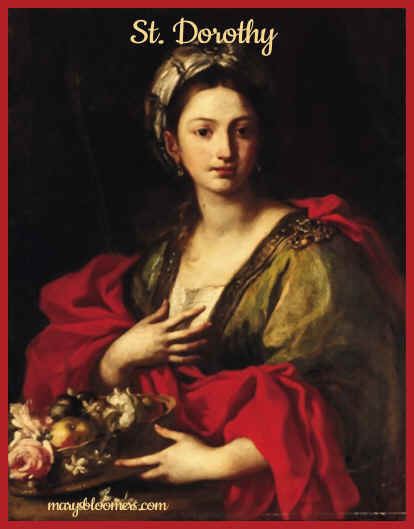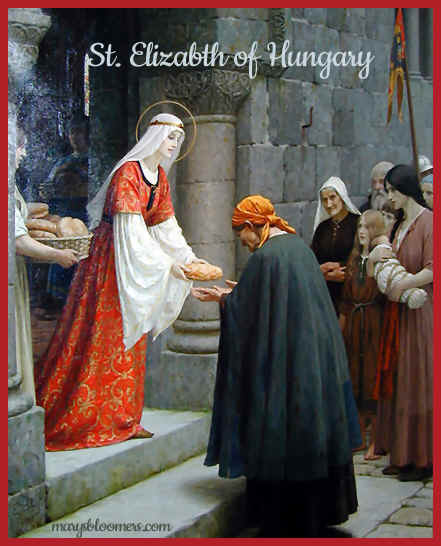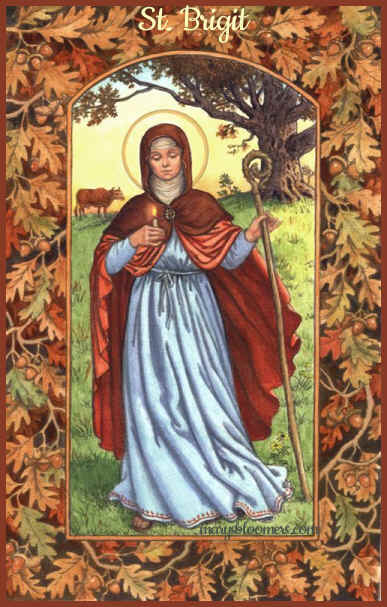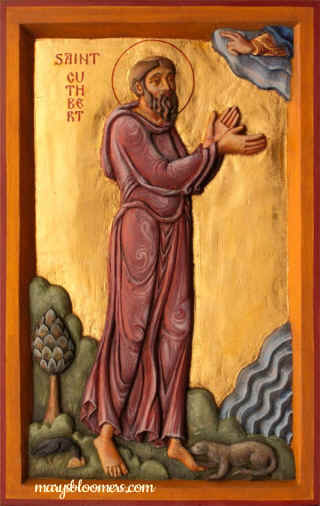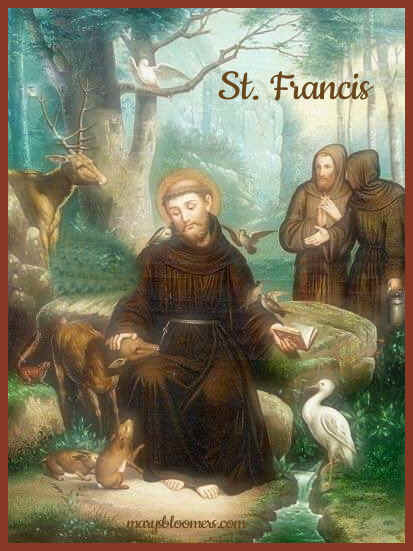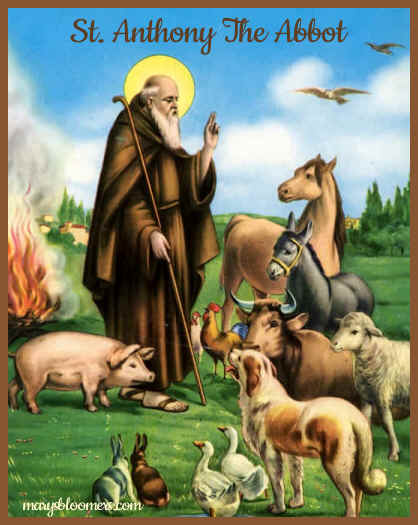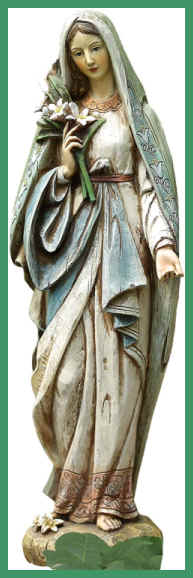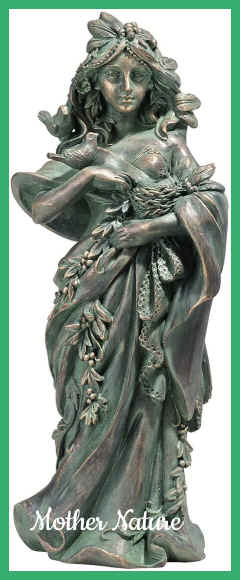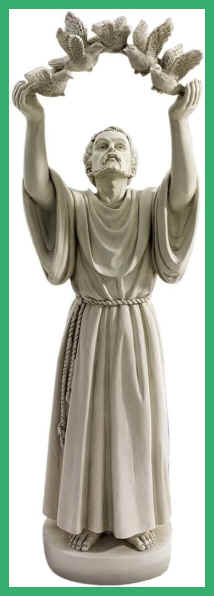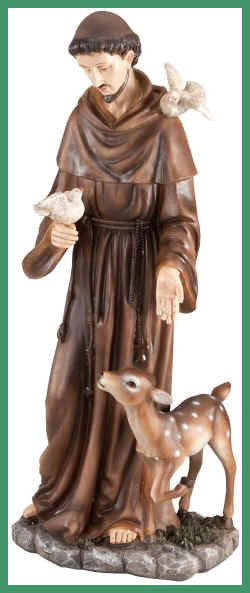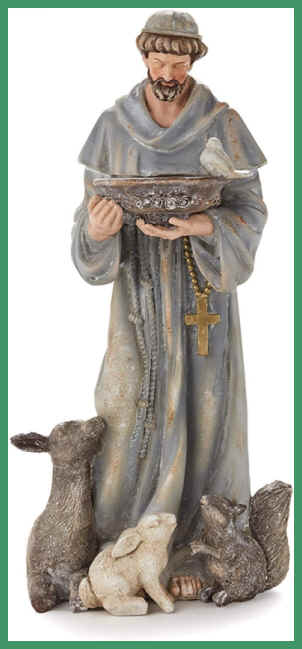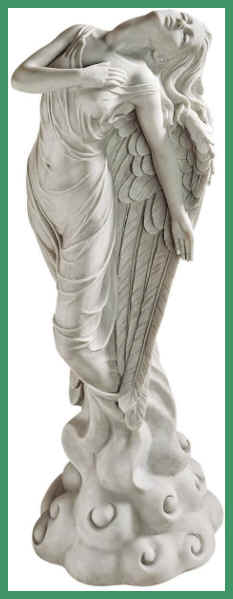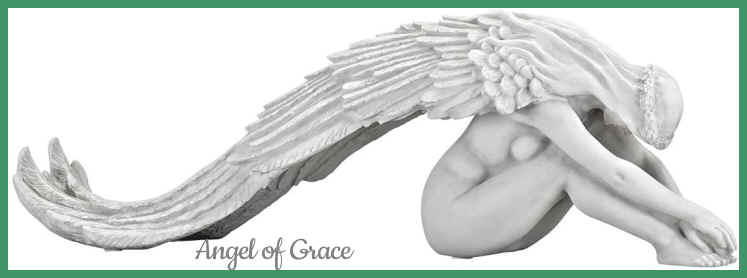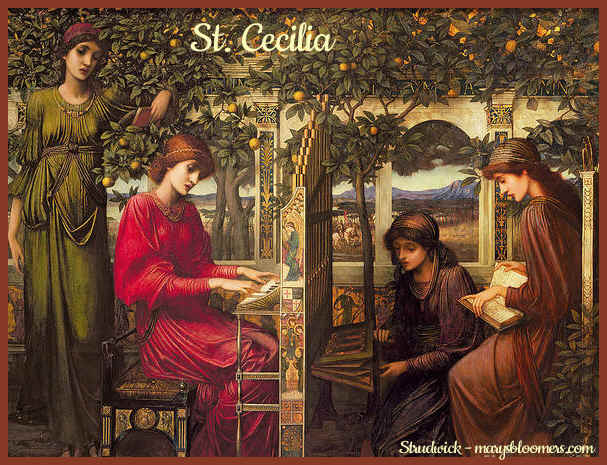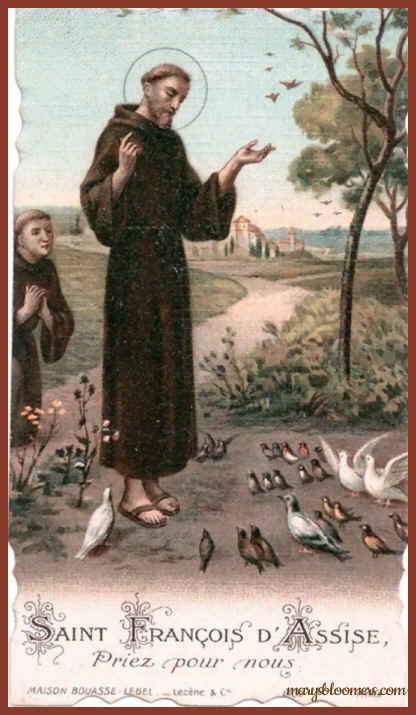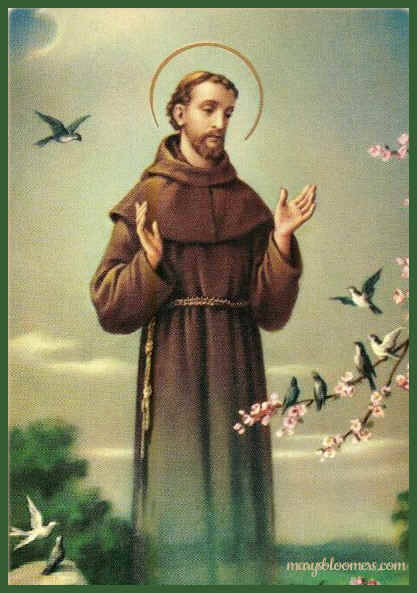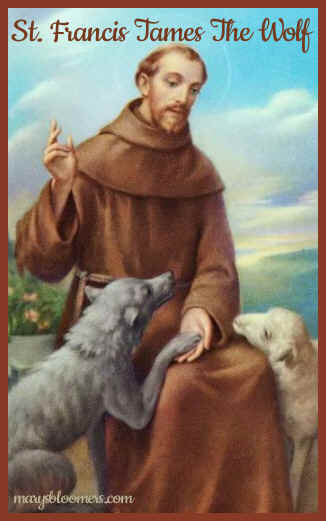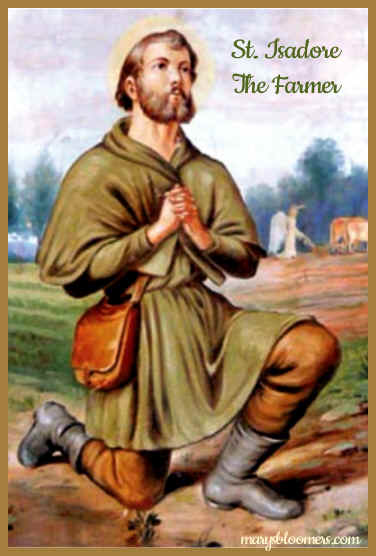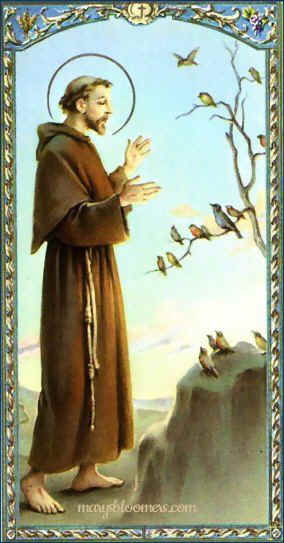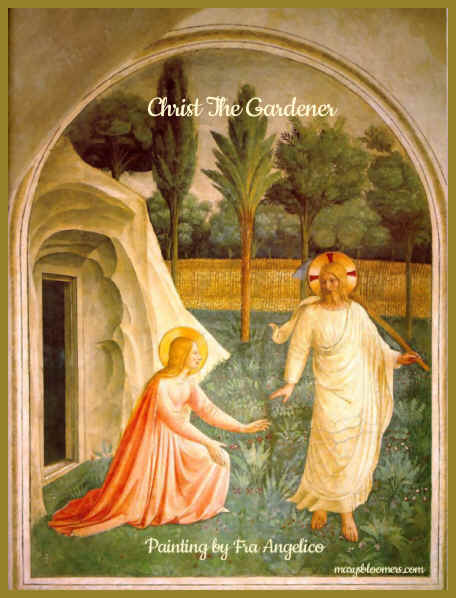A Garden Design That Celebrates The Patron Saints
of Gardens, The Gardeners, and Nature
A garden created as a sacred space,
honoring the patron saints of gardens and gardeners, is an area for
reflection, meditation and prayer, containing flowers and decor that
has inspirational items as its decor, that are related to one or more
patron saints of gardens and gardening. It is by no means
exclusive.... just pick your saints, but concentrate on the garden
patrons. An All Saints Garden would be gorgeous if you wish to make it
all-inclusive. I like the idea of incorporating a Mary
Garden. Statuary and ideas for that sacred
garden-within-a-garden are endless and phenomenal. It's stunning when
it's accomplished
Religious garden statues are
often the focal points of a saint garden. Often, this statuary is of the Virgin
Mary or of a particular patron saint of the garden, or an
entire garden full of of angels and saints. The space need not be big.
It can
be a beautiful surprise in a corner or a nook, or a not-so-secret
fragrant flower garden among or between shrubs and trees. Or a special
focal point in a Moonlight Garden.
A bench or several, or natural
seating areas would be included in the garden, where the visitor can
sit, reflect and meditate. Inclusion of birdbaths and feeders, wind chimes, and anything related to nature and wildlife should also be
included. Combining this design with components of the Feng
Shui Garden design, or the Monastery
Garden, is also unique and desirable.
A beautiful Sacred
Mary Garden design plan can be combined with this garden,
and would make a spectacular retreat. Visit
this page for ideas and beautiful Marian artwork.
Statuary is almost essential. The
beautiful visuals help us to be grateful, prayerful and meditative
when we walk through or sit in that garden. Read further down the page
to read about the saints associated with the garden and Nature.
This year, I dedicated my front
yard garden design to the patrons, saints and angels. My favorite and
most often seen in my gardens is St. Francis, patron saint of gardens,
gardeners, and wildlife. The best place online to buy the best and
most beautiful garden statuary is Design Toscano. There are hundreds
of these saints and other garden statues available from Design Toscano
and other religious statuary sellers on Amazon.
Here's who's revered and
protecting me, my garden, and the wildlife.
Some Flowers To
Grow In A Garden For The Saints
Lilies of all types represent virginity,
and the Madonna Lily is named for and associated with the Virgin
Mary.
St. Dominic, the patron saint of
astronomers, is commonly seen in paintings holding a lily symbolizing
chastity.
All of the virgin saints have a lily as their emblem. St. Anthony is associated with lilies
because it is said that cut lilies placed near his shrine or statue will stay fresh for
many months.
Other flowers associated with Mary can
be found here.
Palms are common in ancient paintings of
Jesus’ entry into Jerusalem.
I grow Dwarf fig trees in my
garden, considering it's Biblical
associations. It works well in big pots along a path, or within a
flower bed. It's relatively small size, and incredibly sweet fruit, fit
perfectly into the theme. There are dwarf and cold hardy varieties to
choose from, or winter them in pots indoors.
Roses are the significant flowers. The Virgin Mary is known as the
“mystic rose’ or the “rose without thorns.”
St. Cecilia is often
shown alongside roses. Along with the palm, the rose is a symbol
of martyrdom. St. Elizabeth of Hungary is associated with a miracle of
roses. St. Rose of Lima is also associated with them. Mary is also
associated with the Iris. A climbing rose, potted rose tree, or ground
roses look and smell wonderful. Irises are perennial and come in all
sizes.
Plant shrubs and flowers that
attract birds and butterflies to encourage a spiritual
remembrance, and to encourage birdsong. Create
a bird and butterfly habitat in or around your garden retreat in celebration and
honor. Plant tubular vines like trumpet vine and Angel's Trumpets to
attract and feed the hummingbirds.
Any beautiful and fragrant flower
should be planted, and a sacred-style decorative item placed nearby.
Especially one that might have a special meaning for you. Do not forget
the fragrances of flowers and healing herbs,
which will add to the meditative and healing effect of the garden.
The Patron Saints of
the Garden and Gardeners
Many saints are patrons of the
garden and natural world, and statues of them are a beautiful addition a
saint garden.
St. Dorothy is the patron of fruit
tree growers and orchards, St. Isidore is the patron or farmers, and St.
Francis of Assisi is the patron saint of gardens, birds and animals. St.
Bernardo Abad, is the patron saint of beekeeping, St. Urban the patron
saint of vineyards and grape growers, St. Fiacre is the patron of herb
and vegetable gardens, St. Elizabeth of Hungary is patron saint of
roses, and St. Phocas is the patron of flower and ornamental gardens.
Saint Francis of
Assisi
St. Francis has
always been my favorite saint and patron of the garden. I think
of him often, as I go about tending the gardens and bird
habitats.
Francis was an Italian religious leader and Catholic mystic, who founded
the
religious order known as The Franciscans.
He is known as the
patron saint of animals, birds, and the environment.
Francis, who
spent his life in poverty and simplicity, realized how important
nature is to man. When Francis received the stigmata, it is said
that his blood turned into roses when it fell upon the
ground.
St. Francis believed that all creatures, not
just humans, must be included in the celebration of Christmas.
He
requested that the emperor ask all citizens to scatter grain along the roads on
Christmas Day, so that the birds and other animals would have
plenty to eat. He also requested that walls should be rubbed with food, and the beasts in the
stable should receive a bountiful meal on Christmas Day.
Gentle Francis
preached to the birds and tamed a wolf. "The Canticle of
The Creatures" was Francis' song of praise and joy., and he
shared it with the birds as he preached. |
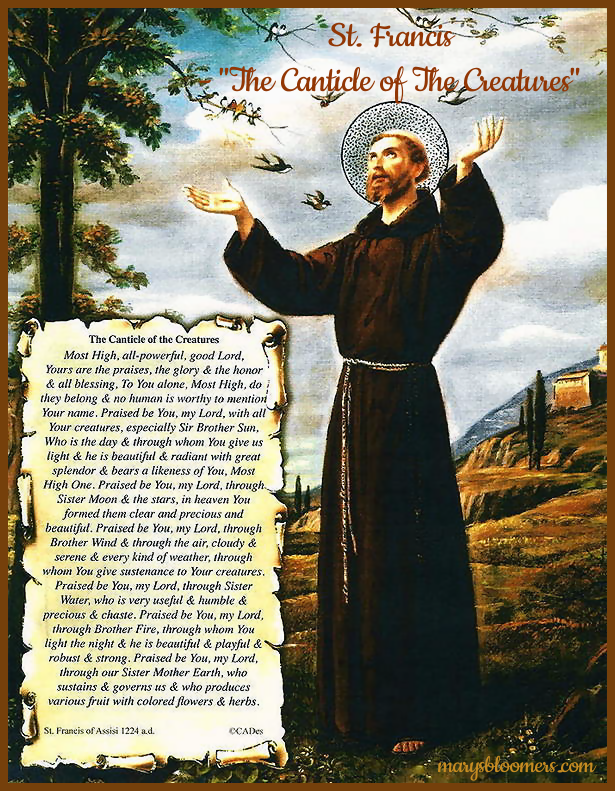
|
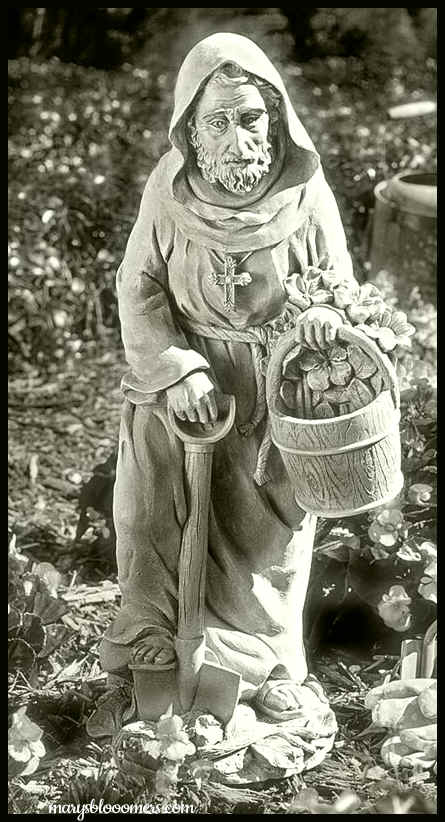 |
St. Fiacre
Saint
Fiacre is the patron saint of growers of vegetables and medicinal
plants, and gardeners in general.
He is commonly invoked to heal persons
suffering from various infirmities, due to his reputed skill with
medicinal plants.
Fiacre
was born in Ireland, and raised in a monastery. His days at the
monastery taught him the joys of planting and harvesting crops and an
appreciation of nature.
He was a hermit and gardener of the seventh
century, who was famous for his sanctity and skill in curing illness and
disease. He emigrated from his native Ireland to France, where he
constructed for a hermitage for himself, together with a vegetable and herb
garden, and a hospice for travelers.
Fiacre decided he
wanted to serve God in solitude, and he established his hermitage
for worship along the Nore River, using a cave for meditation, a
well for drinking water, and the river for bathing.
St. Fiacre petitioned the bishop for land where
he could grow a healing herb garden. The bishop promised Fiacre as much
land as he could entrench in a day. Fiacre then paced the perimeter of
the land he desired, dragging his spade behind him. Wherever the spade
touched, trees were toppled, bushes uprooted, and the soil was
entrenched.
This miracle garden became a place of pilgrimage for
those seeking healing. |
We often
hear stories of St. Francis and St. Fiacre.
But there are several more Patron Saints of Gardens and Gardeners
deserving mention.
St. Adelard
(pronounced Alard)
- He was minister to Charlemagne. He
was later the abbot, as well as gardener ,at the Abbey of Corbie in
Picardy. In church art, he is portrayed digging in a garden, his abbot’s
crown lying on the ground beside him.
St. Ansovino
-
During a terrible famine in Italy, Bishop Ansovino persuaded the haves to
share with the have-nots. He is portrayed standing beside a barn, holding
fruit and garden produce, and is invoked for good harvests.
St.
Brigit
- Brigit grew up in Ireland as a farm worker on her father's land.
Legend
has it that she may originally have been a priestess of the goddess
Brigit, who had powers over healing, poetry, creativity, inspiration,
grain, cattle, and flowers. History documents the friendship of Saint
Brigit and St. Patrick, and it is possible that Patrick converted this
pagan priestess to Christianity. Saint
Brigit, has been described as “Brigit, flowering branch,”.
Her attributes include the wearing of white wool and a white veil, and is
often she portrayed standing beside an altar on which burns her perpetual
fire, accompanied by wild geese or an ox.
St.
Cuthbert
- Born in Scotland, Cuthbert lived alone on a small island. Late
one spring, well past time to plant a crop, he put barley into the ground.
In spite of its the late planting, the barley flourished -- until the
birds arrived to decimate his little field. Scolding, he asked them why
they took what belonged to someone else. If God had given them permission,
fine, but “…if not, get you gone, and do no further injury." The
birds immediately flew away, and never bothered his crops again. He is
often shown surrounded by animals, including otters, who waited upon him
as he prayed, standing knee-deep in frigid waters.
St. Dorothy of Caesarea
- Patron of horticulture, florists,
gardeners, orchards
-Dorothy refused to marry,
saying that Jesus was her spouse. She was mocked on the way to her martyrdom by
a lawyer who told her to send him apples or
roses from her husband's (whom she claimed was Jesus) garden. As she
prepared to die, she saw a girl with a basket of roses and apples, and
asked the child to take these to the lawyer. The girl, actually an angel,
did so. In art, Dorothy (Dorothea) is shown carrying the basket, and wearing a
flowery crown, or in an orchard where the infant Christ can be seen above
her in an apple tree.
St.
Elizabeth of Hungary - Patron of rose gardens
and rosarians
-Elizabeth was secretly taking bread to the poor when her husband, the
king, asked her what she was hiding beneath her apron. When she pulled it
aside to show him, the bread had turned into roses. She is portrayed with
a crown of roses, carrying bread. Add a statue and flowers for Mary to the
garden. She is known as "The Mystic Rose".
St.
Isadore The Laborer, Spain
- Patron
of farmers, market gardens, field workers, and shepherds.
-Isadore's employer once found angels doing Isadore’s work behind the
plow, while Isadore himself knelt in prayer. Isadore the Worker is
portrayed carrying a sickle and a sheaf of grain.
St. Nathan - Patron Saint of Farmers
-Born in Aberdeenshire, Bishop Nauchlan or Nathalan, had spent much time
laboring in the fields, and was renowned for his agricultural skills. He
was also known for his generosity. Once, having given away all his grain
during a famine, he sowed sand for lack of seed, and was miraculously
rewarded with a plentiful harvest.
St. Phocas, The Gardener, Turkey
-Patron Saint of flower and ornamental gardens, farmers, field hands,
market gardeners
Phocas,
an innkeeper and gardener, was revered for his hospitality as well as his
generosity, sharing all he grew with those who were hungry.
St.
Rita of Cascia, Italy -
Patron
of Impossible causes, roses, bees
-As Rita lay on her deathbed in her
convent, her cousin asked if she wanted anything from her old home. She
asked for only a rose and a fig. Although the cousin thought it would be a
wasted trip, she walked to Rita's snowy garden, where she was amazed to
find rose in bloom, and a single ripe fig. Rita is shown with roses and
bees.
St. Swithin -
England - Patron Saint
of rain, invoked to end drought
St. Magnus of Füssen, Bavaria
-St. Magnus is Invoked against vermin, hail, lightening, caterpillars. St.
Magnus watches over plants and the harvest. Legend tells us that Magnus
once rescued a baby dragon and trained it to help local farmers by hunting
rats and other vermin that destroyed their crops.
St. Therese - "The Little Flower
-St. Therese loved nature, and often used the imagery of nature to explain
how the Divine Presence is everywhere, and how everything is connected to
God. Therese saw herself as "the Little Flower of Jesus" because
she was just like the simple wild flowers in forests and fields, unnoticed
by the greater population. Therese did not see herself as a brilliant rose
or an elegant lily, but simply as a small wildflower.
St. Cecilia
-St. Cecilia is the patron saint of music, and in sacred gardens
there are sometimes statues or individual garden spaces that honor her.
Tardens often have bird feeders, bells, wind chimes, and water features to
emphasize nature's music. Plants with berries for the songbirds and
tubular flowers like trumpet vines for hummingbirds are often included.
|
